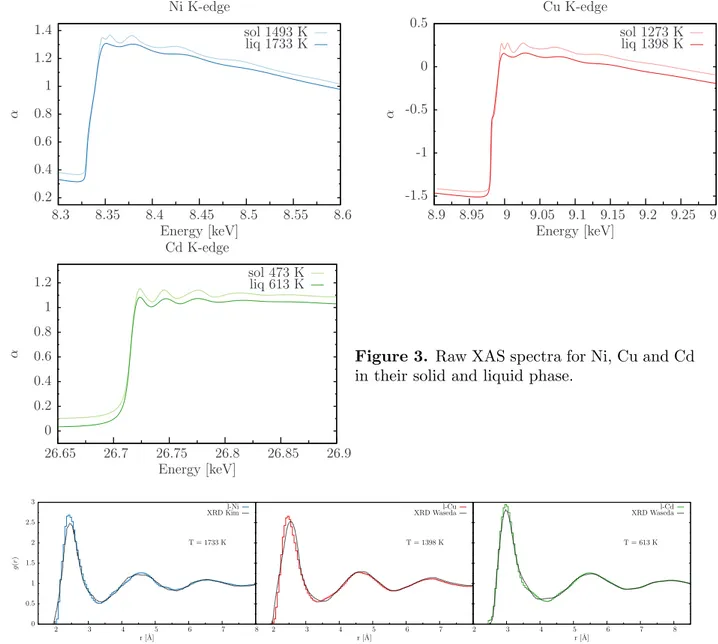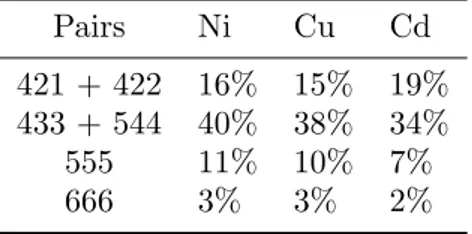This content has been downloaded from IOPscience. Please scroll down to see the full text.
Download details:
IP Address: 193.204.8.28
This content was downloaded on 02/06/2016 at 08:36
Please note that terms and conditions apply.
Local symmetry in liquid metals probed by x-ray absorption spectroscopy
View the table of contents for this issue, or go to the journal homepage for more 2016 J. Phys.: Conf. Ser. 712 012038
Local symmetry in liquid metals probed by x-ray
absorption spectroscopy
Fabio Iesari and Andrea Di Cicco
Physics Division, School of Science and Technology, University of Camerino, Italy E-mail: [email protected]
Abstract. The nature of local point symmetry in simple monoatomic liquids has been a fundamental open question for almost 40 years of computational and experimental studies. We present original results of local ordering in different monoatomic liquids obtained by x-ray absorption spectroscopy (XAS), exploiting its high sensitivity to short-range ordering. We used Reverse Monte Carlo (RMC) analysis (RMC-GNXAS package) for obtaining structural models compatible with XAS experimental data (and diffraction techniques for long-range ordering). Pair, bond-angle distributions and suitable indicators for point symmetry are calculated for different liquid metals.
1. Introduction
The study of local point symmetry in simple monoatomic liquids has been a fundamental and debated topic for almost 40 years of computational and experimental studies, following the initial Frank’s hypothesis [1] about the presence of icosahedral short-range ordering (ISRO) in liquids. The presence of such close-packed five-fold configurations, incompatible with translational symmetry but favored by energetic considerations, was conjectured as a possible explanation for the peculiar undercooling properties of small metal droplets studied by Turnbull in the early fifties [2]. Crystal nucleation [3] is hampered by the positive liquid/crystal inter-facial energy resulting in the possibility to bring a liquid sample into a metastable (undercooled)
molten state below the melting temperature Tm. The debate about presence and amount of
ISRO in undercooled liquids is still open, also because of the experimental difficulties to access deeply undercooled states and the limited structural information supplied by x-ray diffraction experiments. In the last decades, several computational and experimental studies were devoted to investigate locally preferred structures in simple atomic liquids (see for example [4, 5, 6, 7, 8]), and most of these works support the existence and importance of ISRO. In this work, the local order in Ni [9], Cu [10] and Cd [11] is probed by x-ray absorption spectroscopy (XAS), suitable to investigate liquid matter [12] and sensitive to higher order distribution functions. The EXAFS signals are analyzed using a Reverse Monte Carlo (RMC) [13, 14] approach yielding structure models compatible with the measurements and reliable information about presence and amount of ISRO in RMC models is extracted using a suitable geometrical analysis.
2. XAS experiment
Two different sample-environment setup (see [15] and refs. therein) have been used for the present experiments: a furnace for high-temperature measurements (Fig. 1) and a large volume
Paris-Edinburgh (PE) press for high-pressure and high-temperature measurements (Fig. 2).
Figure 1. The furnace used for
high-temperature measurements.
In the inset: the crucible where the sample is inserted.
Figure 2. The Paris-Edinburgh
press for pressure and high-temperature measurements.
Using the first setup, samples are prepared from powder mixture of sub-micrometric metal sample and a filler (Al2O3 for Ni, C for Cu) with a suitable ratio to obtain an optimal XAS
signal, pressed into 100 µm thick 13 mm diameter pellets. The filler powder represents also a container for the metal droplets after melting. The pellets are placed inside a crucible of a furnace, which consist in a 130 mm diameter cylindrical Pyrex glass vessel with a suitable window for simultaneous XRD (x-ray diffraction) and XAS data collection. The heat treatments
are performed under high vacuum conditions P ' 10−5 mbar and temperature measurements
are carried out using a high-temperature pyrometer (estimated uncertainty is 20 K).
Instead, using the PE press setup, we use a 10 mm boron/epoxy toroidal gasket as a container for our powder mixture, together with some other element used as a pressure marker (Si or NaCl). The powder obtained is pressed into a cylindrical shape of about 1.6 mm3, insert into a graphite heater and then loaded in the toroidal gasket. The temperature is controlled by using a K type thermocouple inserted through the gasket. Cd [11] was studied using this setup and some extra precautions were used due to its toxicity.
The temperature behavior of the samples and their phase transformations have been monitored throughout the experiments by ray absorption temperature scans [16] and
x-ray diffraction collected with an area detector. X-ray absorption experiments at variable
temperatures using both sample environment setups were performed at the BM29 beamline (now BM23) of the ESRF (Grenoble) and we were able to obtain data with a good signal to noise ratio (Fig. 3). Pressure behavior of solid Cd was also studied [11], but the data are not shown here as goes beyond the purpose of this paper.
3. Reverse Monte Carlo XAS analysis
RMC is a data-analysis method based on structural modeling, it simulates a cell that reproduces our experimental data. Its basic algorithm is a variation of the Metropolis Monte Carlo method (MMC), but instead of using some model to obtain configurations and then compare them with experimental data, in RMC we directly use the experimental data as a constraint to drive our structures.
RMC modeling was applied to the measured XAS data [14] using the RMC-GNXAS software [17], simulating a 1372-atoms cubic cell with periodic boundary conditions and fixed density. Due to the short-range nature of the XAS signal, the RMC refinement of the liquid systems was carried out using also a measured pair distribution function g(r) ([18, 19]) mainly as a constraint for long-range order. Technical details about the program can be found in Refs. [14, 17].
0.2 0.4 0.6 0.8 1 1.2 1.4 8.3 8.35 8.4 8.45 8.5 8.55 8.6 α Energy [keV] Ni K-edge sol 1493 K liq 1733 K -1.5 -1 -0.5 0 0.5 8.9 8.95 9 9.05 9.1 9.15 9.2 9.25 9.3 α Energy [keV] Cu K-edge sol 1273 K liq 1398 K 0 0.2 0.4 0.6 0.8 1 1.2 26.65 26.7 26.75 26.8 26.85 26.9 α Energy [keV] Cd K-edge sol 473 K liq 613 K
Figure 3. Raw XAS spectra for Ni, Cu and Cd in their solid and liquid phase.
0 0.5 1 1.5 2 2.5 3 2 3 4 5 6 7 8 g (r ) r [˚A] T = 1733 K 2 3 4 5 6 7 r [˚A] T = 1398 K 2 3 4 5 6 7 8 r [˚A] T = 613 K l-Ni
XRD Kim XRD Wasedal-Cu XRD Wasedal-Cd
Figure 4. Pair distribution functions obtained from averaging over 100 RMC configurations.
A total of 100 different box configurations, obtained after convergence to a minimum and reproducing our experimental data, were finally considered.
4. Data analysis and results
Pair distribution functions for the three liquids were calculated using the equilibrated RMC configurations (Fig. 4) and found to be in good agreement with the ones obtained from XRD and used as a constraint for long-range order. The first minimum in the g(r) was used to define the distance to consider first near-neighbor atoms.
To analyze the local geometry we used common-neighbor analysis (CNA) [20]: each pair of nearest-neighbor atoms is classified by using a set of three indexes jkl: j is the number of nearest neighbors common to both atoms, k is the number of bonds between the common neighbors, and l is the number of bonds in the longest continuous chain formed by the k bonds between common neighbors. This method is able to distinguish between various local structures:
555 pairs are characteristic of icosahedral structures (ICOS), 544 and 433 are characteristic of strongly distorted or defective icosahedra (DICOS), 666 are found in bcc structures, and 421 and 422 are characteristic of fcc and hcp ordering [18]. These geometrical structures are the most abundant in our models, and their relative weights are reported in table 1, normalized to the total number of nearest-neighbor pairs.
Table 1. Percentage of pairs from CNA obtained from RMC configurations
Pairs Ni Cu Cd
421 + 422 16% 15% 19%
433 + 544 40% 38% 34%
555 11% 10% 7%
666 3% 3% 2%
The results reported in table 1 show that defective and distorted icosahedra are the most present structures in our model, as well as non-negligible percentages of nearly-perfect icosahedra.
On the other hand, structures reminiscent of the crystalline phase are present. It is interesting to notice that in the Cd case, the ISRO is less abundant. This is probably connected to the fact that Cd is not exactly close-packed in its crystalline phase and this is also reflected in its liquid phase. These findings support and quantify the presence of ISRO in close-packing liquid metals, for which a complete analysis of short-range structure and local symmetry will be presented elsewhere.
References
[1] F. C. Frank, Proc. Royal Society London A 215, 43 (1952). [2] D. Turnbull and R. E. Cech, J. Appl. Phys. 21, 804 (1950).
[3] K. F. Kelton and A. L. Greer, Nucleation in Condensed Matter (Elsevier, Amsterdam, 2010). [4] P. J. Steinhardt, D. R. Nelson, and M. Ronchetti, Phys. Rev. Lett. 47, 1297 (1981). [5] S. Nos´e and F. Yonezawa, J. Chem. Phys. 84, 1803 (1986).
[6] H. J´onsson and H. C. Andersen, Phys. Rev. Lett. 60, 2295 (1988). [7] T. Kondo and K. Tsumuraya, J. Chem. Phys. 94, 8220 (1991). [8] S. Mossa and G. Tarjus, J. Chem. Phys. 119, 8069 (2003). [9] A. Di Cicco et al., Phys. Rev. B 89, 060102(R) (2014).
[10] A. Di Cicco, A. Trapananti, S. Faggioni, and A. Filipponi, Phys. Rev. Lett. 91, 135505 (2003). [11] M. Minicucci et al., Physica Scripta. T115, 1056 (2005).
[12] A. Filipponi, J. Phys.: Condens. Matter 13, R23 (2001). [13] R. L. McGreevy and L. Pusztai, Molec. Simul. 1, 359 (1988).
[14] A. Di Cicco and A. Trapananti, J. Phys.: Condens. Matter 17, S135 (2005). [15] A. Di Cicco et al., Journal of Non-Crystalline Solids 352, 4155 (2006). [16] A. Filipponi et al., Rev. Sci. Instrum. 71, 2422 (2000).
[17] A. Di Cicco et al., GNXAS, extended suite of programs for advanced x-ray absorption data-analysis: methodology and practice (TASK Publishing, Gdansk, 2009).
[18] T. Kim and K. Kelton, J. Chem. Phys. 126, 054513 (2007).
[19] Y. Waseda, The Structure of Non-Crystalline Materials (McGraw-Hill, New York, 1980). [20] J. D. Honeycutt and H. C. Andersen, J. Phys. Chem. 94305, 4950 (1987).


